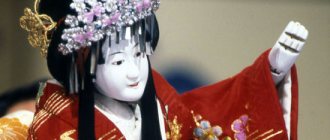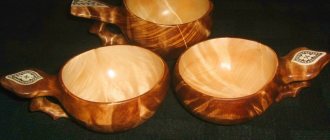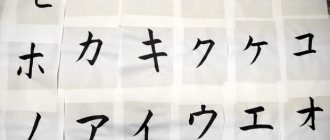Origami is perhaps one of the most versatile hobbies in the world, because it is difficult to find someone who is not interested in it. For children, this is the necessary development of fine motor skills, accuracy, perseverance, attentiveness and logical thinking. For adults, this is a very simple and accessible way for everyone to relieve stress, relax, take a break from routine and switch gears. Even if you look at a piece of paper for the first time with thoughts of making something out of it, it doesn’t matter! We have already prepared several simple patterns for beginners!
Origami swan
Take a square white sheet, mark one diagonal and bend the upper and lower corners to it. Fold the ends of the corners in the opposite direction, fold the piece in half and place it on the table like an open book. From a long, elongated corner, form the neck and head of a swan. Make a beak by bending the tip of the head back and forth, and then draw the swan's eyes.
Simple and understandable art for children
Easy origami paper crafts allow children to subsequently become interested in this type of art. In addition, such activities have a positive effect on the overall development of the child, so it is worth making sure that the child loves such work, does not give up when failures occur, and is confident in his abilities. There are a number of specific rules that will help you quickly learn how to make origami.
Origami paper bunny
Fold a square piece of paper in half and mark the middle of the triangle. Bend its base back a little, and then fold the triangle ears up. Tuck and hide the top and bottom corners of the square to form a muzzle and color it.
Origami cosmetic decoration
Origami paper crafts for children will be a wonderful hobby. Colorful mushrooms can be an excellent decoration for the home; they will be especially useful when decorating an apartment during some holiday. In addition, the child will be interested in the process of creating such decor.
Origami whale
Take a gray or blue square, mark a diagonal and bend the lower fragment towards it. Turn the workpiece over and bend the upper and lower (already folded) parts towards the middle. Fold another small corner at the top to form the back, flip the piece over again and make a whale's tail.
How to make origami flowers from paper: 8 best patterns
Paper fox
Mark the diagonals of the square and fold it in half into a triangle. Fold the corners of the base up to create a small layered diamond again. On one side, bend the corner and turn it around so as to form a muzzle with ears. Now you just need to draw a nose with eyes and bend the tail so that the fox can stand.
Origami flower
Fold a square piece of paper in half horizontally and tuck in the top corners to form an isosceles triangle. Bend the corners of the base of the top layer up, slightly at an angle to the middle, and do the same on the other side - you will get a square. Bend its side corners to the middle from all sides, straighten it and slightly inflate the figure. Form the petals and straighten the bud by hand on all sides.
To make a flower stem, take a green square, mark a diagonal and bend the side corners to it. Repeat the action for the bottom part, and then again to get a thin rhombus, as in the diagram. Fold the lower elongated part up - this will be the stem of the flower, and bend the wide part and fold it into a leaf.
Modular origami
Such crafts consist of individual repeating modules, most often triangular. On the Internet you can find many photos with masterpieces from modules: swan, peacock, elephant, owl, umbrella, etc.
After making several models using photos and diagrams, you will definitely want to take a creative approach to the origami process and come up with your own modular craft.
Bright garlands
For a mushroom garland you need to take white and red paper. The legs are white, and the caps are red with white spots, like fly agarics. Collect all the mushrooms on a string, in the form of a garland. It can be used to decorate a child’s room or veranda in the fall. You can attach it to the balcony, the garland will make it more colorful and fun.
It is very useful to make an anti-stress snake toy using the origami technique. For it you need to cut colored strips of paper 35 mm wide and 20 cm long. Glue strips of the same color, two pieces in length. Then you need to take two such strips of a contrasting color and glue them at one end at an angle of 90°. Next we weave them together, alternating strips. When the weaving comes to an end, we glue strips of a different color, lengthening them again with contrasting colors. When all the strips are assembled, glue the ends together. The snake is ready.
You can make garlands for the New Year tree. For example, from squares of colored paper measuring 7x7 cm. By making simple balls, diamonds, tubes and stringing them on a thread, you can get bright products for the Christmas tree.
Christmas decorations
On the eve of the New Year, one cannot help but mention Christmas tree decorations. They are also made from paper using the origami technique easily and quickly. Balls, stars, birds, umbrellas turn out very funny and bright. Having made a colored ball, you can put it on a longer thread, put a star made smaller than the ball lower, and attach a tassel even lower on the thread. You can also add beads. And of course, we must not forget about the loop by which you can hang the toy on the Christmas tree.
Christmas tree decorations can be made from the pages of bright glossy magazines with pictures, then the toys will be multi-colored and will sparkle in the reflection of the light garland. Manufactured birds, whose legs are made of wire wrapped in thread, can simply be placed on a Christmas tree branch, bending the legs around the branch.
Making objects using the origami technique relieves stress and has a beneficial effect on the nervous system. It is impossible to learn this technique simply by studying diagrams; you need to open some kind of master class, pick up colored paper, scissors and start creating. Undoubtedly, origami will become your favorite hobby!
Origami paper dove
Fold the square sheet diagonally and turn the corners at the base of the triangle upward. You will get a rhombus, which needs to mark the middle and side verticals, as in the diagram. Hide the side corners of the diamond inside, fold the piece in half and turn it over.
On both sides, lift up the future wings of the dove and give them shape. Bend your torso into a trapezoid so that the tail goes down and spread your wings. All that remains is to bend the head-beak on the neck, and the messenger of peace is ready!
10 best plans for making a paper airplane
Origami technology and child development
The fact that the technology of making paper figures without the use of glue and scissors is quite useful for the development of a child has been known for quite some time. Even in his time, Lev Nikolaevich Tolstoy predicted a great future for this type of art. We can see this in his book called “What is Art.” Here the great writer claims that all products and patterns for origami help the child not only develop physically, but also morally.
This technology is of such great importance, because in the process children develop their hands and helps the child work with small parts. Both for older children and for children, such skills are useful because thanks to such work, the baby develops hand motor skills more and thus, his correct coordination significantly increases.
Paper cracker
A paper cracker is folded from a rectangular sheet - you can even use a double notebook. Fold all four corners towards the middle and fold the piece in half into a trapezoid. Fold the corners of the trapezoid down and fold it in half again to create a three-dimensional triangle. You need to take it by the sharp end and shake it sharply so that all the air comes out of the figure with a characteristic pop.
Origami styles
Despite the fact that the method of folding paper may seem rather monochromatic, origami still has several styles:
- the classic method is the ability to make a variety of products from an ordinary square piece of paper;
- modular style is when you make an origami product using your own hands using individual components of the whole. This option is considered one of the most popular among others;
- There is also a simple way to work in the style of paper folding technology. This option was invented by the British so that people with disabilities could also practice this art. Often this style of work is used by inexperienced and beginners;
- A very interesting option is the wet version of paper folding. The sheet is first moistened with water using a spray bottle and only then work begins. Thus, the figures have quite smooth and smoothed edges;
- The most difficult style is considered to be working on a pattern. In the process, it is necessary to draw drawings and lines on paper and only after that can you get the desired shape.
Origami paper frog
Mark the diagonals, central vertical and horizontal lines of a square sheet of paper. Fold it in half and bend the corners inward, as in the diagram, to form an isosceles triangle. Fold the corners of the top layer towards the middle, fold it back halfway and turn the figure over.
Fold the triangle into a rhombus, bend its side corners to the middle, and then straighten the top one into another triangle. Fold the lower part (legs) up and down like an accordion, as in the diagram, turn the toad over and watch how it jumps if you press with your finger.
The Art of Kiri-e: Paper Creations
Greetings, dear friends! Today, in the “ Interesting in the World ” section, I invite you to take a virtual trip around Japan. Tourists who have visited Japan are amazed by the richness of the culture of this country. Getting to know kiri-e, a popular type of decorative art, leaves a particularly vivid impression. The topic was called “The Art of Kiri-e: Creations from Paper.”
The first acquaintance with the traditional Japanese art of kiri-e is admirable for anyone. These airy paper creations amaze with the precision of the smallest elements. To master this type of paper plastic, you need to be patient. After all, even an experienced master spends a lot of time creating one painting. But if you follow the technique, you will get a real work of decorative creativity.
What is the art of kiri-e: the history of the emergence of this movement
Many art connoisseurs call the unique technique kiri-e - magic at the tip of the blade. And, indeed, masters who have been engaged in this type of creativity for many years create entire paintings with various subjects from a sheet of ordinary paper. By the way, literally translated from Japanese, kiri-e means “carved pattern,” which reflects the technique of obtaining the image.
Although kiri-e is today considered a property of Japanese culture, this unique style of carving came to the land of the rising sun from China at the beginning of the 7th century. It is interesting that in the Celestial Empire they began to practice figure cutting just a couple of centuries after the advent of paper. It is known that this perfect material was first obtained in 105.
Today this type of creativity is very popular in all corners of the planet. The best art rooms are dedicated to presenting the works of the most famous kiri-e masters. Moreover, each artist has his own cutting technique, that is, a special handwriting by which experts can recognize the master.
Features of the Kiri-e technique
Paper figurines were very popular in ancient Japan and China. The Japanese carved them to decorate sacred places, and the Chinese used paper stencils for embroidery. Subsequently, the inhabitants of the Land of the Rising Sun also began to cut out paper stencils to make it more convenient to apply hieroglyphs to the kimono.
Only several centuries later, kiri-e emerged as a separate direction of decorative art. Anyone can learn this type of creativity. After all, to create unique paintings you need tools that are in every home:
- Knife or blade.
- Plain paper.
- A little free space.
- A little patience and skill.
Some contemporary artists experiment using unconventional tools such as a scalpel. Not without a creative spark, masters create three-dimensional creations from paper, while other artists try to apply designs on a plant base. Passionate about their work, they spend hours creating ornate patterns so that enthusiastic spectators can admire the beauty of the paper canvases.
Top Artists: 10 Famous Kiri-e Masters
Unfortunately, there are only a few craftsmen who are fluent in the technique of creating filigree patterns on paper. Therefore, exhibitions of their works attract great attention. Let's talk briefly about each of the 10 most famous artists in the world.
The Japanese master Riu perfected the technique of paper carving. Using an ordinary stationery knife, he creates fantasy paintings. The artist claims that his innate sense of rhythm helps him create. You can get to know him and his work better by following the link on Instagram.
British artist Pippa Dirlaga works with a scalpel. She first prepares a stencil, and then spends hours cutting out complex patterns suggested by her imagination. Her Instagram profile link.
Filipino Patrick Cabral is famous all over the world. He is more attracted to the animal world, and his main profession as a web animator helps him create unique figurines of fauna in 3D format. You can get acquainted with his works by following the link.
Susie Taylor from Hertfordshire is also known far beyond the UK. Her graceful paper creations amaze with their airy lightness. The master gives preference to floral motifs and art-folk. You can see Susie's new works by following the link.
Microorganisms brought fame to the American Rogan Brown The master chose such an unusual subject for creativity not by chance: through creatures cut out of paper, he is trying to tell people how fragile our world is. Rogan sometimes uses laser cutting to create his unique works. Find out more about the life of Rogan Brown on Instagram here.
Continuation…
Kiri Ken is the pseudonym of another famous Japanese master. It is translated as “cutting sword.” The main theme of the artist’s creative works is the life of sea creatures, but sometimes she cuts out portraits. In addition to knife and paper, Kiri Ken uses ink. By following the link on Instagram, you can subscribe and see the artist’s new works.
Japanese Hina Aoyami works in the best traditions of the Kiri-e technique. She has been interested in paper carving for more than 20 years. Now the artist lives in France, and devotes all her free time to her favorite hobby. Many art lovers are familiar with her lacy flowers, inscriptions and butterflies. The artist constantly posts her works on Instagram. Link.
Korean master Yo Hong uses the herringbone technique and a special paper cutter. He creates portraits of famous personalities. To improve visual perception, a dark background is placed under the cut-out design.
Artist Bovee Lee was born in Hong Kong, but then moved to the United States. The master carves his masterpieces on rice paper or silk. Her creations have virtually no weight, but make a stunning impression. The artist creates each plot first in electronic form, and then transfers it to fabric or paper.
Indian artist Parth Kotekar , one might say, created a new direction in kiri-e. At first, paper carving was a common hobby, but soon he became so passionate about creativity that it became his life’s work. The artist’s weightless works amaze with their precise, thin lines. He expertly cuts out every feather, every hair on paper. You can get acquainted with him and his works via the link on Instagram.
Interesting Facts
Short and rather interesting facts that will allow you to learn a little more about this amazing type of creativity:
- The Moscow Museum of Oriental Art still houses dozens of works by Chinese Kiri-e artists, which reflect the stages of development of the young communist state: combine harvesters, party congresses. There is even a unique painting depicting the Moon Goddess meeting the first Soviet satellite.
- At first, cuttings in China were used as templates for embroidery, but then they turned into an independent type of decorative art.
- The Japanese found a new use for paper cutouts - they began to be used as templates for dyeing kimonos.
- Omid Asadi, an artist from Iran, carves patterns not on paper, but on dried tree leaves.
- In ancient times, the Chinese carved symbolic patterns on red paper. Such images played the role of talismans, guaranteeing the owner health and prosperity. Today, such attributes are sold to tourists in the Middle Kingdom.
- Europe only began to mass produce paper in the 16th century. Therefore, they began to engage in decorative creativity here much later than in the East.
Finally
Today there are not many artists engaged in kiri-e art. But they are real magicians: it is quite difficult to sit for hours and cut out filigree lines, but this results in work of incredible beauty.
In conclusion, I invite you to watch a video I edited, which I called “The Art of Kiri-e: Paper Creations.”
Thank you for your attention, dear readers! If you are interested in knowing what interesting things are happening in the world, subscribe to updated articles in the “ Interesting in the World ” section or watch videos on my YouTube . Also, do not forget to recommend the article to your friends on social networks!
May everything be fine with you, Vera
Origami mouse
Mark the diagonal of the square sheet and bend the upper and lower corners towards it, and then bend them back and forth to the middle again. Straighten the diamond as shown in the diagram and turn its corner down. Turn the corner of the main diamond in the opposite direction, and then fold the edges again.
Turn the figure over and straighten the protruding triangles into the mouse's ears. Bend the long triangle twice into a mouse tail and tuck it so that the figurine can be placed on the table. All that remains is to finish drawing the face with eyes and nose.
How to make a paper crane: 8 simple ideas
Origami is a great hobby for a child
It is important to note that this type of art has many positive aspects for a child. In addition to the development of creative abilities already mentioned above, origami allows a child to explore the world around him through the study of created figures.
The number of different patterns for paper origami that can be found on the Internet represents an inexhaustible supply of inspiration for creativity.
Paper crane
An origami crane is a little more difficult to make for a beginner, but quite possible. Fold the square of paper diagonally twice to form a small triangle and place it “book” side down. Unfold the top layer into a square and flip it over, as in the diagram. Turn the trapezoid over to the reverse side and arrange the second triangle into a square with the book facing down.
Fold the side corners of the top layer back and forth towards the middle and unfold it into a long elongated diamond, and then do the same on the other side. Fold the side corners towards the center, as in the diagram, and bend the long “legs” to the sides - this will be the neck and tail. Form a head on the neck and finally spread the wings of a crane.
History of Origami: Paper Folding Culture
Origami has existed in Japan since the seventh century AD. That is, approximately from the time when, thanks to the borrowing of technology from China, washi paper appeared on the Japanese islands. The first crafts made from folded paper were part of a Shinto ritual: it is believed that the development of origami began with the spread of the custom of wrapping offerings to deities in paper. During the Muromachi period (XIV-XV centuries), the samurai clans of Ogasawara and Ise established the rules of origata - regulations for packaging various items intended for offering in washi paper. Decorated envelopes for cash gifts for weddings and other celebrations, which are still used today, are echoes of origata.
Origata style ceremonial wedding offerings
During the Edo period (XVII-XIX centuries), with the spread of washi, paper folding became one of the folk pastimes, loved not only by children, but also by adults. Then this fun received its current name - origami. The oldest known book on origami today, “The Secret of Folding a Thousand Paper Cranes” (Japanese: Hiden senbazuru origata) was published in 1797. It includes 49 patterns for folding paper cranes.
Today, origami is used for both educational and rehabilitation purposes in Japan and around the world. New folding patterns are spreading at lightning speed thanks to the Internet - through thematic sites and videos; folding techniques sometimes develop in completely unexpected directions. The art of origami, which initially gained popularity as entertainment, does not stand still, but moves with the times.











